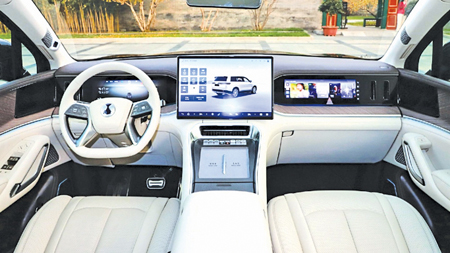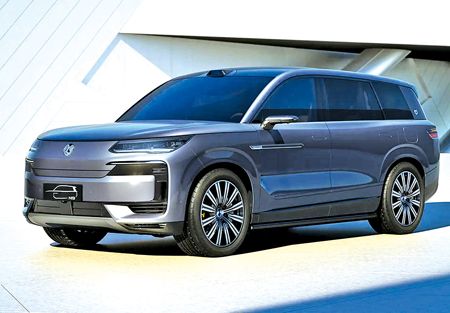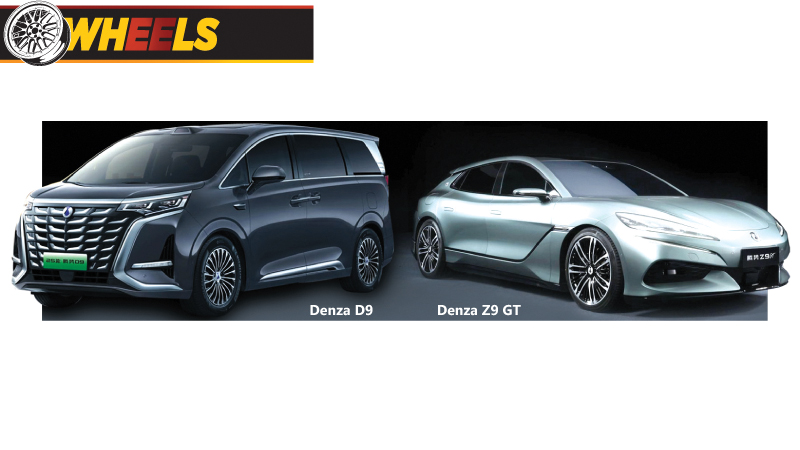John Keells Auto and China’s Build Your Dreams (BYD) last week entered into an agreement for the launch of BYD’s Denza luxury vehicles in the Sri Lankan market, following the highly successful introduction of BYD’s namesake vehicles.
Local customers have already placed over 5,000 firm orders for BYD hybrid and electric vehicles including Sealion 6, Dolphin, Seal, Atto and Shark 6 4WD pickup (which was also launched at the same event) at its four showrooms.
With Denza, BYD and John Keells hope to tap into the luxury market at prices that are much more affordable than those of premium German marques. In fact, those visiting the Cinnamon Life hotel in Colombo can already see a fleet of Denza cars reserved for the use of hotel guests.
 According to the agreement, the first Denza cars destined for individual customers will reach our shores by July. BYD also hopes that Denza will be much in demand from the tourism and hospitality sector. Incidentally, Sri Lanka is one of the first markets in Asia-Pacific other than China and Singapore to get the Denza brand, which was introduced to Europe just last month.
According to the agreement, the first Denza cars destined for individual customers will reach our shores by July. BYD also hopes that Denza will be much in demand from the tourism and hospitality sector. Incidentally, Sri Lanka is one of the first markets in Asia-Pacific other than China and Singapore to get the Denza brand, which was introduced to Europe just last month.
Denza began life as a joint venture in 2010 with the quintessential German luxury brand Mercedes Benz, but it is now wholly owned by BYD. In a short period, Denza has become a competitor for Mercedes itself, not to mention BMW, Porsche, Audi and Lexus.
Manufactured in China
While BYD does have an even more luxurious brand in Yangwang, Denza easily straddles between premium luxury and affordability, making it an ideal choice for most buyers. Wolfgang Egger, who previously led design teams at Audi and Lamborghini, has joined BYD as chief designer, making the cars very appealing to European and Asian buyers.
All Denza models exported to Sri Lanka will be manufactured in China, although BYD is planning to start production at its first European plant in Hungary, in October. A second BYD site in Turkey is expected to come on line in March 2026. BYD also has a plant in Brazil. When fully operational, they will have a total production capacity of 500,000 hybrid and electric cars per year.
Denza offers a range of luxury cars, SUVs and vans, with the Denza N9 SUV leading the pack. On May 21, Denza announced that the 10,000th unit of its N9 model has officially rolled off the production line. The N9 adopts Denza’s signature design language, featuring sleek, narrow headlights flanking a front fascia with C-shaped air intakes and an active grille. A roof-mounted LiDAR radar unit hints at the inclusion of advanced intelligent driving capabilities.
Along the sides, the N9 is equipped with electronic rear-view mirrors to enhance visibility and driving safety. The rear design is upright and solid, with full-width tail lights that echo the shape of the front lamps, visually extending the vehicle’s width.
Inside, the N9 features a tech-forward cabin centred around a T-shaped dashboard. It includes a 13.2-inch digital driver display, a 13.2-inch front passenger entertainment screen, and a 17.3-inch floating central touchscreen. The four-spoke steering wheel carries physical buttons and scroll wheels for ease of operation.
Sports model
The Z9GT sports model is another car that buyers here will look forward to as it apparently represents the “best of BYD technology and the best of BYD design”. At its heart is Denza’s own e3 Platform, which brings a number of headline features. Certainly one of the most striking is its rear-wheel dual-motor independent steering, which enables the right and left wheels to steer independently of the front axle and of each other. As well as allowing drivers to toe in and toe out of tight spaces, it also allows the car to “crab walk”—where the auto seemingly glides in a sideways motion—up to an industry-leading angle of 15 degrees.

Denza N9 SUV
This eminently trickery is controlled by Z9GT’s Vehicle Motion Control architecture, which can take over braking, suspension, and steering—even in the case of a high-speed tire blowout, where it can adjust the torque of the unaffected tires, redistributing the power at speeds of over 160 Kmph.
The new Platform allows the Z9GT to adopt a Cell-to-Body structure, which sees the Blade Battery integrated into the car’s architecture, as seen in the BYD Seal. Aside from a stiffening boon to the chassis, this ensures a fully flat floor and helps to create an additional 15-millimetre vertical space in the cabin for as much room inside as possible.
Inside, customers will find premium leather seats and wooden accents across the dash, with 128-colour lighting for setting the cabin ambience. Front seats will get 12-way electric adjustment and 10-point massage and heating, along with active side bolsters, which share their air tanks with the car’s air suspension for additional support during cornering. The Z9GT will offer a choice of powertrains at launch, either pure electric—launching first in November—or Super DM hybrid, which will come with a 2-litre turbocharged petrol engine and follow in February 2026.
Multi-screen interactive experience
The D9 is a van that competes with the likes of Lexus LM, Toyota Alphard and Toyota Wellfire. The model comes with eight trim levels, including five plug-in hybrid electric vehicle (PHEV) variants and three battery electric vehicle (BEV) versions.
Highlights include the addition of LiDAR sensor, the introduction of the “God’s Eye” advanced driver assistance system, and the use of BYD’s latest fifth-generation DM hybrid technology. The front features a large chrome grille, with silver trim redesigned into an “L” shape, and sharp LED headlights on both sides, giving the vehicle a more elegant and impactful look.
The new model adds LiDAR on the roof and side cameras on the fenders to support advanced driving features. It features a 15.6-inch floating central control screen, a 10.25-inch fully digital instrument cluster, and adds a 10.25-inch HD co-pilot screen, enabling a multi-screen interactive experience.
Other notable features include a 12.8-inch rear seat multimedia screen, a 5.2-inch smart refrigerator screen, a multifunctional double-LCD-setup in the centre armrest, a HUD (Head-Up Display) for the driver, and a streaming media rear-view mirror.
The vehicle supports connectivity of up to 10 screens, with individual screen control and shared multi-screen functionality. The second-row seats also feature a 1,080mm electric sliding rail to maximise space, along with 14-way power adjustments, leg rests, and a 16-point massage function for enhanced comfort.
The third-row seats are equipped with three sets of child seat anchors, ventilation, heating, and seatbelt reminder features. The new hybrid D9 models come with a 39.938 kWh lithium iron phosphate battery pack. The CLTC battery-powered range is 200 km for the two-wheel-drive version and 190 km for the all-wheel-drive version. With a full charge and a full tank of fuel, the vehicle’s combined range can reach up to 1,100 km (two-wheel drive) and 1,020 km (four-wheel drive). As a seven-seater, the D9 is ideal as a family and tourism vehicle.




